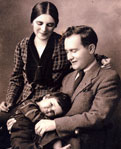
Miriam Menkin with her husband and son
Last month I attended a lecture presented by Sarah Rodriguez, PhD addressing Miriam Menkin’s role in early in vitro fertilization (IVF) research. Many people outside the world of reproductive endocrinology know very little about Menkin, if anything at all. Often when her name is mentioned, it is in regard to her relationship with John Rock and not as a scientist in her own right. In her lecture, Dr. Rodriguez gave Menkin her own story and in doing so, argued that we should rethink her contribution to IVF as well as how gender limited women’s opportunities in the scientific community.
Although she was a brilliant woman who aspired to become a doctor, Menkin like so many other women during the early 20th century, was unable to get an advanced degree preventing her from fully pursuing her own scientific interests. Her lack of sufficient academic credentials, gender and familial obligations prevented her from doing research in her own laboratory so she spent most of her career as a lab assistant helping other scientists with theirs. In 1937, she began working as a lab tech for John Rock to help him with, “the hunt for eggs,” and in 1944, she presumably discovered the first instance of IVF in Rock’s laboratory. In a cruel twist of fate, Menkin was forced to move out of state shortly after this discovery when her husband’s position at Harvard was not renewed. She spent six years away from Rock’s laboratory and returned only after she divorced her husband, but by that time Rock had moved onto birth control research. Menkin was never able to return to IVF research; however, it always remained her desire to.
As Menkin demonstrates, women have not been absent from scientific research in the early 20th century, many simply haven’t shared in the spotlight with their male counterparts. Who knows what Menkin might have achieved, had she been afforded the resources to continue exploring IVF. Although none of the 5 embryos produced in Rock’s laboratory with Menkin’s assistance resulted in a live birth, she was still an integral player in establishing that embryos could in fact, be created outside of the human body. To listen to Dr. Rodriguez’s lecture on Miriam Menkin, please click *here.
*An audio recording of this lecture will be made available within the next week.

